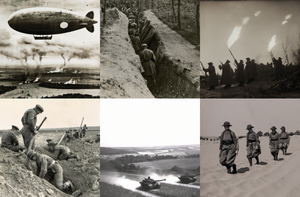Copper War
| Copper War | |||||||
|---|---|---|---|---|---|---|---|
 Scenes from various fronts of the Copper War, depicting airship raids, trench warfare, landships and the usage of flamethrowers | |||||||
| |||||||
| Belligerents | |||||||
|
Central Powers: |
Quintuple Entente: | ||||||
| Strength | |||||||
|
Literally God from heaven |
| ||||||
| Casualties and losses | |||||||
| no one | dignity, pride, economy, etc. | ||||||
The Copper War (often referred to as the Great War) was a wide-reaching global military conflict that lasted from 4602 CY to 4607 CY. It was a result of mounting tensions between the major world powers of the time. It led to the mobilisation of X million military personel and is the single deadliest conflict in history, with an estimated X million combatant deaths and X million civilian deaths as a direct result of the war. The war would see the first large scale use of machine and trench warfare, making the war a slow and brutal affair that would see the nations in the war pushed to their economic limits. The middle of the 46th century would see great technological progress becoming commonplace across North Yazland and the world. Developments of new military technologies which relied on copper as a main component began an arms race between the various powers of Yazland and a desire to hold control over the international copper trade. This came to a breaking point in 4602 CY, when a dispute over privateering between Chiöq, Dhimrai, Tschintiessteiss, and Wadiin would cause Dhimrai to declare war on TSC.
Background
With the development of new military technologies in the 4Xth century—such as Tanks, Landships, and Airships—the demand for the copper necessary to construct these machines would skyrocket. Causing countries to rush towards whatever sources of copper they could find. This race to control the copper trade would affect the countries of Dhimrai and Tschintiessteiss in particular, as the copper-rich TSC would attempt to prevent Dhimze from gaining any share in the copper market. The two powers would engage in a large-scale proxy trade war, manipulating and negotiating with foreign powers to give a disadvantage to the other in the market. Principally, these two would find allies in Huo, TSC primarily with Chiöq and Dhimrai primarily with Wadiin. The two kingdoms controlled colonial empires in Huo and Jarruunh, in which they’d extract copper to fund their own arms and to sell to other powers.
Prelude
Following Dhimrai’s entry into the Black Wars, the military would see an extreme need for copper to maintain current vessels and to create new ones. Dhimrai had been losing the ongoing trade war with Tschintiessteiss over copper, as TSC and its allies would outcompete Dhimrai and it’s allies, making the process of attaining copper unwieldy and unprofitable for Dhimrai and it’s allies. This resulted in a copper shortage in Dhimrai, which set in almost immediately after entering the Black Wars. The leaders of Dhimrai, desperate for resources, constructed a plan between themselves and the government officials in Wadiin to regain a foothold in the copper market. Wadiin would hire an expansive amount of privateers to raid copper shipping between Chiöq and TSC, these privateers would then sell the copper at an affordable price to Dhimrai, under the guise of being “merchant shipping.” Following the implementation of this plan, and the restoration of a copper supply for Dhimrai, the governments of Tschintiessteiss and it’s allies would take notice, demanding answers from the governments of Wadiin and Dhimrai. The Dyaway of Wadiin would not accept responsibility for the raids on merchant shipping but began an official government investigation to reprimand the privateers, though in practice the investigation would never get off the ground due to intentional delays. The Delegate(?) of Dhimrai denied all connection with the privateers, claiming they were simply buying copper from a private source. The government of Tschintiessteiss, though annoyed with these responses, took steps to avoid war, instead sending the navy to arrest suspected privateers to aid Wadiin in their official investigation. In response, the Dhimze Navy was sent to protect the privateers and Dhimrai’s copper trade, with the Delegate(?) claiming that Tschintiessteiss should not unlawfully detain ships inbound for Dhimrai. The tensions came to a boiling point when on 29 Giulan 4602 CY, a Tschintierst attempt to detain a privateer ship and a misunderstanding between Dhimze and Tschintierst forces led to a minor skirmish, which saw a Dhimze vessel sunk. Dhimrai would declare war on Tschintiessteiss less than two weeks later, on 17 Uinte 4602.
Fronts
Aftermath
Belligerents
Central Powers
Yazland
Etzavaz
Ashnan
Huo
Quintuple Entente
Yazland
Etzavaz
Ashnan
Huo
Technology
War crimes
sus.png